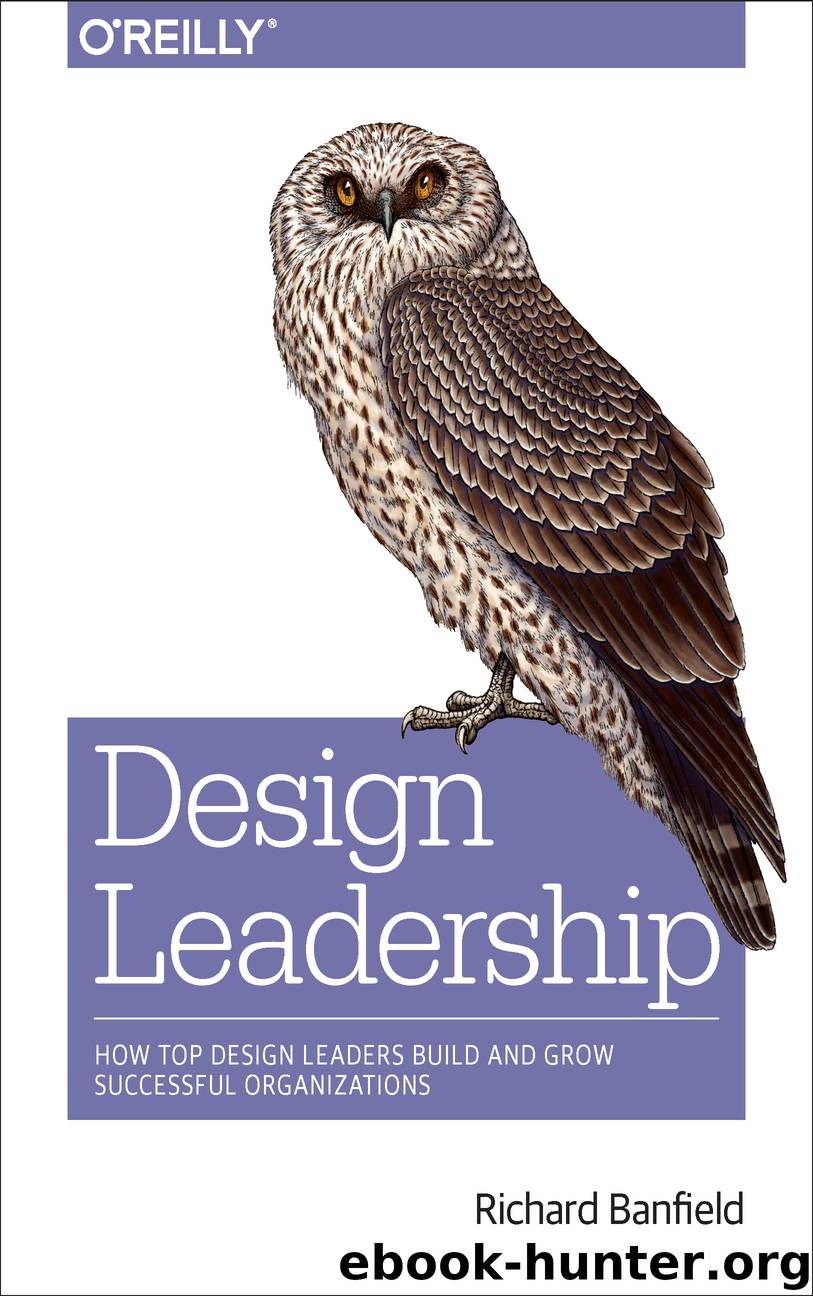Design Leadership by Richard Banfield

Author:Richard Banfield
Language: eng
Format: epub
Publisher: O'Reilly Media, Inc.
Published: 2015-12-02T16:00:00+00:00
That Pesky Ambiguous Future
We also asked the design leaders what they see when they look at the industry as a whole. We wanted to know what they see coming down the line in the way of opportunities, challenges, and trends. Dominic Bortolussi of The Working Group sees a future where clients want more than just design and development services. “I think one thing that we’re uncovering for ourselves is that as the size of our clients grows—they’re getting bigger and bigger, national and international companies—we’re realizing that they’re looking for someone who provides more than just the production, more than just slapping design on a piece of software. They’re looking for the smarts and the strategy in advance of that. We’ve always provided that, but we never focused on that until recently because our genesis was as a development shop.”
As design teams grow and their skills go beyond pushing pixels, the desire to take on more strategic work increases. More strategic work means more internal planning. Delivering on complex projects requires teams with training in strategic thinking. “In the past, we were just the guys behind the scenes who’d be coding the apps,” says Bortolussi. “As the size of our projects has grown, the need for that type of strategy has grown. That means that agencies like ours are going to need to be able to offer more and more of that type of work in concert with the development process. Using the agile process, which is something that we’ve adopted over the last three or four years, strategic thinking is very tightly intertwined with the production. Every cycle ... goes through a piece of strategic process and strategic thinking about what you want to develop and why you want to develop it and how to prioritize that.”
The lesson here is that planning for successful outcomes at the project level also means flexing your planning muscles at the company level. The two are always connected. You can’t deliver strategic value to your clients if you can’t answer those questions for your own design organization. “Educating our clients into that process is going to lead to better things, better production, better software,” continues Bortolussi. “I think that’s a common theme that we’ve seen with a lot of our peer agencies around here. Rather than just being the design and dev shops, they’re being asked their thoughts and expertise on how to design a [website] for a client based on their business needs.”
Habanero Consulting has been in business for two decades, and CEO Steven Fitzgerald is planning for several more decades of business. With so many short-term-focused planning methodologies like Agile and Lean gaining popularity, you might mistakenly think that long-term planning was only for your dad’s generation. You’d be wrong. Whether they actively plan for the future or not, all our design leaders think about what the long-term future will mean for their teams and opportunities. Planning far ahead can seem daunting, but that far-away future appears to excite our design leaders.
Download
This site does not store any files on its server. We only index and link to content provided by other sites. Please contact the content providers to delete copyright contents if any and email us, we'll remove relevant links or contents immediately.
| Decorative Arts | Design History & Criticism |
| Furniture Design | Industrial & Product Design |
| Interior & Home Design | Jewelry Design |
| Textile & Costume |
POP by Steven Heller(3326)
Japanese Design by Patricia J. Graham(3138)
The Power of Broke by Daymond John(2933)
Architecture 101 by Nicole Bridge(2782)
Indistractable: How to Control Your Attention and Choose Your Life by Nir Eyal(2359)
Fusion 360 for Makers by Lydia Sloan Cline(2336)
Batik by Rudolf Smend(2151)
Actionable Gamification: Beyond Points, Badges, and Leaderboards by Yu-kai Chou(2141)
Origami Art by Michael G. Lafosse & Richard L. Alexander(2081)
Homebody by Joanna Gaines(2049)
Whiskey in a Teacup by Reese Witherspoon(1957)
Worn in New York by Emily Spivack(1946)
Feng Shui by Stephen Skinner(1917)
Austin Kleon by Steal Like an Artist(1906)
Simple Gatherings by Melissa Michaels(1884)
Don't Make Me Think, Revisited: A Common Sense Approach to Web Usability by Steve Krug(1839)
Ryan Korban by Ryan Korban(1736)
Hygge: The Danish Art of Happiness by Marie Tourell Søderberg(1711)
The Joy of Hygge by Jonny Jackson(1706)
